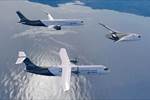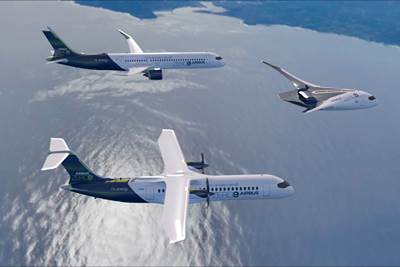EXAELIA project to develop research testbeds for next-gen airliners
Cranfield University, along with 23 partners including Airbus, GKN and Collins, are building their knowledge of tube and wing and BWB aircraft concepts through development of testbed research aircraft.

Source | Getty Images
(Bedford, U.K.) is playing an important role in a new project, (EXperimental Aircraft for European Leadership in Aviation), that is developing the testbeds needed to pave the way for next-generation aircraft.
Led by the Dutch National Aerospace Laboratory (NLR, Amsterdam), EXAELIA is a 42-month €16 million project with 23 partners in 13 countries that are collaborating to develop knowledge around building and using smaller scale flying testbeds. These testbed research aircraft, which will be reused for additional flight test needs, will test new concepts and technologies and are crucial to help researchers and engineers learn how new technology long-range aircraft will work.
The project focuses on three main areas — tube and wing (TaW) aircraft with long, slender wings, blended wing body (BWB) airliners and new propulsion systems, particularly hydrogen propulsion. All of these novel technologies aim to significantly reduce the emissions from aviation, ultimately achieving net zero.
Cranfield is leading the design of the BWB testbeds, developing the legal paradigms and flight test practices for all testbeds, as well as making a major contribution to the design of hydrogen powertrains. Cranfield will also support four Ph.D. students in this work, who will graduate ready to work on the next stage of building and operating these testbed aircraft.
“Our involvement in EXAELIA builds on nearly 80 years of aeronautical innovation here at Cranfield,” notes Dr. Guy Gratton, associate professor of aviation and the environment, and also Cranfield’s principal investigator and leader in flight test practice work. “Reaching net-zero emissions from aviation requires a radical rethink of aircraft concepts, and this project has a crucial role in helping to de-risk and validate the technologies that will take us there.”
Gratton led the previous EnabEl (Enabling Aircraft Electrification) program and was the test pilot who made the first flight of the Sherwood eKub, said to be the first British designed and built all-electric conventional airplane. He is supported by reader in airframe systems, Dr. Craig Lawson, who is leading this project’s BWB design work.
EXAELIA project partners are also supported by Airbus, Safran, Rolls-Royce, MTU, GKN Aerospace, Collins Aerospace, Honeywell Aerospace Technologies, Piaggio Aerospace, KLM Royal Dutch Airline and ITP Aero.
Cranfield University, which also owns and operates Cranfield Airport, is exploring new aircraft designs and the potential for hydrogen in aviation, with a at any U.K. airport. According to Aviation Week, the university’s BWB expertise to the building of a full-scale blended wing fuselage mock-up in conjunction with the U.K.’s University of Greenwich, and its division, Cranfield Aerospace, building two X-48B experimental BWB aircraft for Boeing which were tested with NASA.
Funded by the European Union under GA No. 101191922. Views and opinions expressed are however those of the author(s) only and do not necessarily reflect those of the European Union or the European Climate, Infrastructure and Environment Executive Agency. Neither the European Union nor the granting authority can be held responsible for them.
Related Content
Otto Aviation launches Phantom 3500 business jet with all-composite airframe from Leonardo
Promising 60% less fuel burn and 90% less emissions using SAF, the super-laminar flow design with windowless fuselage will be built using RTM in Florida facility with certification slated for 2030.
Read MorePlant tour: Collins Aerospace, Riverside, Calif., U.S. and Almere, Netherlands
Composite Tier 1’s long history, acquisition of stamped parts pioneer Dutch Thermoplastic Components, advances roadmap for growth in thermoplastic composite parts.
Read MoreInfinite Composites: Type V tanks for space, hydrogen, automotive and more
After a decade of proving its linerless, weight-saving composite tanks with NASA and more than 30 aerospace companies, this CryoSphere pioneer is scaling for growth in commercial space and sustainable transportation on Earth.
Read MorePlant tour: Aernnova Composites, Toledo and Illescas, Spain
RTM and ATL/AFP high-rate production sites feature this composites and engineering leader’s continued push for excellence and innovation for future airframes.
Read MoreRead Next
Airbus pushes ZEROe aircraft project timeline to 2040s
Hydrogen-powered aircraft program is being delayed from original 2035 plan, with Airbus expanding nearer term plans to flight test SAF engines for a next-gen single aisle instead.
Read MoreAurora reveals SPRINT fan-in-wing design progress
Development of uncrewed demonstrator with 45-foot wingspan, 1,000-pound payload to prove high-speed, vertical-lift, runway-independent mobility.
Read MoreCutting 100 pounds, certification time for the X-59 nose cone
Swift Engineering used HyperX software to remove 100 pounds from 38-foot graphite/epoxy cored nose cone for X-59 supersonic aircraft.
Read More












